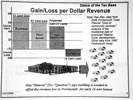Affordable housing meets PowerPoint in Portsmouth
Update: I'm not going to edit this post, because it's more than a year old, but I do want to point out that this was a quick, initial response, and that it is not accurate. While my argument about year-round residents may be valid in a perfect world, it fails when viewed in light of Rhode Island's tax cap.
Eileen Spillane down the road in RI12 picks up on a Newport Daily News story about the recent report of the Portsmouth Economic Development Committee. The NDN story apparently focused not on the good work the committee did, or their plans for 2007, but on one extremely stupid chart they presented which suggested that the most profitable housing sector to pursue was "Recreational/Residential" (i.e., houses for rich people who only live here part time and don't use so many services.) As Eileen points out:
"Responsible economic development requires affordable housing for its workers. While Newport shoulders much of this for the State, what about Portsmouth? It's time that other towns & cities stepped up to the plate. I proposed the State providing incentives for communities to do so." — RI12
 Here's the offending chart. (Click for larger view) Based on the numbers, developments like Carnegie Abbey look good on paper, because residents only use them for part of the year, and absorb only 43 cents of services for every tax dollar they contribute. Residential households, on this chart, project below the line, "costing" 16 cents more than they produce in taxes.
Here's the offending chart. (Click for larger view) Based on the numbers, developments like Carnegie Abbey look good on paper, because residents only use them for part of the year, and absorb only 43 cents of services for every tax dollar they contribute. Residential households, on this chart, project below the line, "costing" 16 cents more than they produce in taxes.
Now there are at least two things wrong with this kind of analysis, and both of them are pretty egregious. On a practical level, saying that part-time residents are economically attractive does not speak to their total lifecycle cost. While they are less likely to have kids in the schools or require municipal services, they are also less invested in supporting the town. They don't pay sales tax here full time, don't shop here full time, don't raise families here. I'm not saying that's good or bad; this is not a criticism of part-time residents. It is, however, a critique of the snapshot analysis in this chart versus a long-range picture. The uncaptured cumulative local revenue (and its velocity multiplier) need to be subtracted from that alleged 57 cents. Nor does this analysis attempt to quantify the cost of less-than-full community participation, an intangible to be sure, but that's what consultants get paid to operationalize.
But even worse, and the reason charts like this help towns make dumb decisions about housing is the tacit metaphor: Government is a business. That's just flat wrong.
Let me say it again. Government is not a freaking business. You are not "losing money" on residential homeowners, as if they were some unprofitable assembly line you could outsource to Mumbai. Governments provide municipal services because they serve the common good, not because they turn a profit, and we forget that at our peril. Words matter, and the EDC would do well to think more carefully about them in the future.
This dumb chart and the NDN pickup is particularly unfortunate, because the rest of the work the EDC has been doing — promoting Wind Power, developing the Town Center project, and working to attract businesses to Portsmouth — have been laudable.
Shout out to Eileen's RI12 for pointing out this article.